List of edible plants and mushrooms of southeast Alaska facts for kids
Southeast Alaska is a special place with a unique climate. This climate helps many kinds of edible plants and edible mushrooms grow there. Most of the area is covered by the Tongass National Forest, which is a temperate rainforest. This rainforest gets a lot of rain, and the temperature stays pretty steady. This allows many plants and fungi to grow well.
Long ago, during a time called the Little Ice Age, huge glaciers covered Southeast Alaska. When these glaciers melted about 10,000 years ago, they left behind soil full of good nutrients. These nutrients made the land very rich, helping all the plants and animals in the area thrive.
Contents
Tlingit People and Foraging
For a very long time, the Tlingit people of the Pacific Northwest found their food directly from the land. Their traditional Tlingit cuisine included everything from whales and deer to clams and plants. They often ate many edible items from the local plants, along with seafood and wild game.
Sometimes, hunting and fishing trips were not successful. On those days, meals were made using local berries, fungus, and seaweed. Winters in the Pacific Northwest were long and cold. So, the Tlingit people used special ways to preserve the plants they gathered. This meant they could eat them all winter long. Today, many edible plants eaten in Southeast Alaska are known because the Tlingit people passed down their knowledge through many generations.
Delicious Berries of Alaska
Southeast Alaska is home to many tasty berries! They are great to eat fresh or can be made into jams and jellies.
| Common Name/Scientific Name | Tlingit Name | Image | How to Eat Them | Fun Facts |
|---|---|---|---|---|
| Lowbush cranberry, Lingonberry | Dáxw | 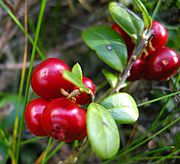 |
Eat them raw, or use them in jams and jellies. | They are ready in late fall. These berries are packed with healthy stuff called antioxidants. |
| Thimbleberry, Rubus parviflorus | Ch'eex' | 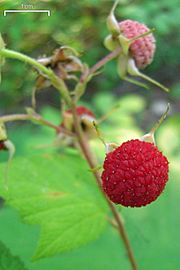 |
Eat them raw, or use them in jams and jellies. You can also eat the young shoots raw or cooked. | They look and taste a lot like raspberries. |
| Strawberry | Saákw |  |
Eat them raw, or use them in jams and jellies. | They ripen in late spring. You can mash their leaves to make a tea. |
| Salmonberry, Rubus spectabilis | Was'x'aan Tléigu |  |
Eat them raw, or use them in jams and jellies. You can peel and eat the young shoots raw. | You can find them in July and August. They grow well on rainy, sunny hillsides. |
| Nagoonberry, Rubus arcticus | Neigóon |  |
Eat them raw, or use them to make juice and tea. | Look for them in damp, low meadows. These berries are very delicate and not usually found in large amounts. |
| Bunchberry, Cornus canadensis | K'eikaxétl'k | 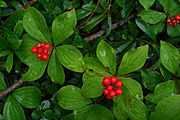 |
You can eat them fresh or freeze them to save for later. | They have a lot of pectin, which helps jams set. Berries ripen later in higher places. |
| Huckleberry | Tleikatánk | 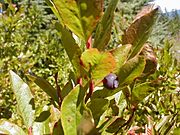 |
Eat them raw, or use them in jams and jellies. | They grow on sunny hillsides. Sometimes, you might find small worms in them. |
| Highbush cranberry, Viburnum trilobum | Kaxwéix | 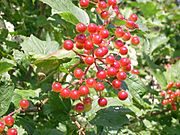 |
They taste tart if you eat them raw. | They produce fruit in late summer. You can find them in woods and on rocky banks. They have more pectin earlier in the summer. |
| Gooseberry, Ribes uva-crispa | Shaax | 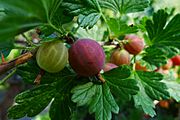 |
You can eat them raw. | They are ready in mid-August. These berries have a unique smell. |
| Elderberry, Sambucus | Yéil' | 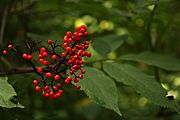 |
You can eat the flowers and ripe fruit (without seeds) raw. | The berries can sometimes be found high up, even 20 feet! Cooking the berries removes something that might upset your stomach. Be careful: seeds, unripe berries, stems, and roots can be poisonous. |
| Cloudberry, Rubus chamaemorus | Néx'w | 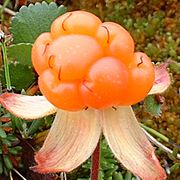 |
Eat them raw, or use them in jams and jellies. | They produce fruit in late fall. You can use their leaves to make a special tea. |
| Twisted Stalk, Wild Cucumber, Watermelon Berry, Streptopus amplexifolius | Tleikw Kahínti | 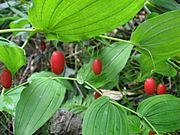 |
You can eat the berries and young stems fresh or raw. | The berries have a light flavor, like watermelon. The stems taste similar to cucumber. They grow in shady, moist places. Be careful: the poisonous False hellebore plant sometimes grows nearby and has similar leaves. |
| Alaskan Blueberry | Kanat'a | 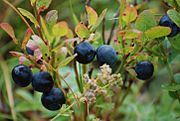 |
Eat them fresh, or use them in jams, jellies, and baked goods. | They ripen from mid-July to late August. They grow on wet, sunny hillsides. |
Fungi: Mushrooms of the Rainforest
The Tongass National Forest is a temperate rainforest, and it often produces many mushrooms in the summer and fall. Fungi are important for the environment. They help recycle nutrients in the soil, hold water, and provide food for many animals. People can also use fungi for dyeing natural fibers or as a food source. Some common types of fungi include Chanterelles, Boletes, Morels, and Puffballs.
Safe Mushroom Harvesting
If you want to pick mushrooms in the Tongass National Forest for yourself, you usually don't need a special permit. However, it's important to protect nature and not damage the forest. If someone wants to pick mushrooms to sell, they need a special permit. Always check with a local forest ranger to make sure you are picking mushrooms legally and safely.
Important Safety Tip: Many types of mushrooms can be poisonous, even if they look like edible ones! It's very important to be absolutely sure what kind of mushroom you are picking. Picking the whole mushroom (including the base) and noting where it grew can help with identification. Also, remember that all harvested mushrooms need to be cooked; never eat them raw.
| Common Name/Scientific Name | Image | Fun Facts |
|---|---|---|
| Shrimp russula, Russula xerampelina |  |
When it gets older, it can smell a bit like fish. This is the most common russula mushroom people eat. |
| Orange milk-cap, Lactarius deliciosus group | 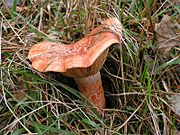 |
This mushroom turns green after you touch it. People gather it for food, but the ones in Alaska are not thought to be as "delicious" as others. |
| The gypsy, Cortinarius caperatus | 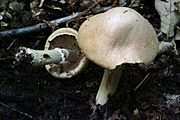 |
The gypsy mushroom can be tricky to identify. It can be confused with more dangerous types, so be very careful. |
| Alaskan gold, Phaeolepiota aurea | 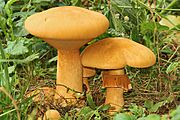 |
This one is easy to identify. You often find it in areas where the ground has been disturbed, and it grows in large groups. |
| Pacific gold chanterelle, Cantharellus formosus | 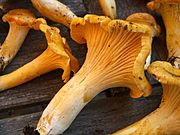 |
These are large mushrooms, but you usually only find a few at a time. They smell a bit like apricots. |
| Yellow foot, Craterellus tubaeformis | 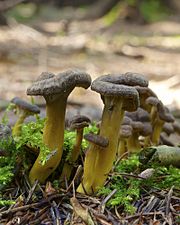 |
These mushrooms are small, thin, and shaped like a trumpet. They grow for a long time during the season. |
| Black chanterelle, Polyozellus multiplex | 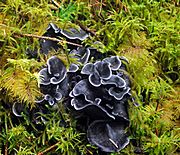 |
This mushroom looks very unique and striking. It usually grows in tight clusters under spruce trees. It is quite rare. |
| King bolete, Boletus edulis | 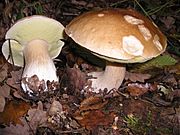 |
This is a very popular mushroom to eat. The tubes under its cap can also be used to make a dye. |
| Admirable bolete, Boletus mirabilis | 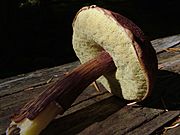 |
It usually grows on wood. Some people say it has a lemony taste. |
| Chicken of the woods, Laetiporus sulphureus | 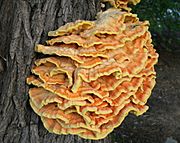 |
This mushroom grows in large clusters with shelves that can be over 12 inches wide. The young, fresh ones are the best to eat. |
| Bear's head, Hericium abietis | 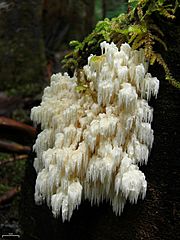 |
This fungus looks very distinctive, almost like a shaggy white pom-pom. It usually grows on conifer logs and stumps. |
| Gray fire morel, Morchella tomentosa | 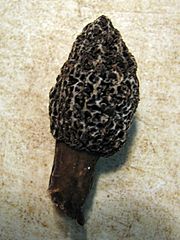 |
It is very dark when it's young, but it gets lighter as it gets older. Many people think it's one of the best edible fungi in the area. |
| Early false morel, Verpa bohemica |  |
This is one of the first mushrooms to appear in late spring or early summer. For some people, eating the early false morel can cause an upset stomach. |

